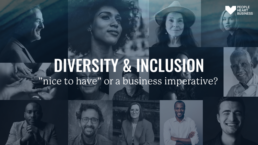Diversity & inclusion – “Nice to have” or a business imperative?

Diversity inclusion
– “Nice to have” or a business imperative?
Recently Allbright presented their report on Diversity in Swedish business. Even if the topic of diversity has become increasingly important for many organizations, change is slow.
According to the World Economic Forum (2023) it would still take approximately 130 years to close the inequality gap at the current pace, despite an increased global focus on gender diversity at work.
Many organizations and leaders are under extreme pressure due to the past years of pandemic, a financial downturn, technical advancements in society and higher expectations on sustainability. Even so, increasing pressure by adding DEI perspectives is necessary to be future ready and successful long-term.
In 2025, 75 percent of the workforce will be made up by millennials. According to Deloitte, DEI is one of their top two questions when assessing an employer. So not only does DEI have a positive effect on innovation, financial performance, and collaboration, it will also be critical to attract the workforce of tomorrow.
A global large cap organization reached out to People Heart Business for support in this area. Why us? A small startup, with little experience in DEI itself? We don’t know. But DEI leads the organization to larger questions. To work with DEI successfully the organization needs to center it in the business strategy, look at the performance of the executive management and CEO as well as the culture and leadership in the organization. The work needs to be done with integrity and in a way that builds trust and allyship throughout the organization. The partner needs to be capable of both handling complex logical and emotional challenges. We won the competition against international giants. It is a big responsibility and thus we partnered up with Chisom Udeze and Diversify – a consultancy with vast experience in DEI, with clients such as UN, the Economist and Boston Consulting Group.
To succeed we will always rely on the competence and trust of our clients, network, and partners.
We take humble pride in our purpose to unite people in solving the unsolvable!
What are your best tips when it comes to successful DEI-work?
Making the traditional player innovative and human centric
Making the traditional player innovative and human centric
Situation
How to make the successful large traditional player leave the safe space and move into uncharted areas making it successful going forward?
With strong market performance, over 10 000 employees with a high engagement for the company, and large and satisfied customers – why change?
…Because the world changes, and what made this organization successful now or in the near future will not be the answer to long-term success. To lead the future, the organization needed to have a higher focus on innovation and sustainability, transforming their leadership to handle the fourth industrial revolution and have a higher focus on human centricity to attract both customers and the next generation workforce.
The organization had been built on strong individual leaders and business units. Even though collaboration was a core value, it had not been core to the Executive Management Team, creating frustration and inefficiency in the next level of the organization. At times, the executive management team became more of a suppressor, than an enabler of innovation in the organization. To compete at scale and drive innovation, there was a need for alignment, efficiency, and collaboration.
The newly appointed CEO reached out to People Heart Business to get support in this transformation – to unite the executive management team around the critical success factors for the future and role model a human-centric way of working.
The results

PERFORMANCE

STRATEGIC FOCUS

TEAM CLIMATE
Percentage experiencing a high degree of increased performance.
- New performance management measurements from the board throughout the organization covering and driving both financial and non-financial targets
- Higher pace in driving the strategic agenda for sustainability, innovation, people and efficiency
- Improved team climate and power balance supporting the future success of the company
- Members not supporting or able to drive the shift leaving the team and giving space to diverse perspectives on future success
The solution
People Heart Business, together with the CEO, decided to start focusing on the Executive Management Team, but with important input from external and internal stakeholders. The first phase built important trust and engagement in the organization for the newly appointed CEO, it helped the management team to stop, reflect, and see the severeness in the gathered feedback from owners, board, customers, and employees. The feedback highlighted many positive areas and built pride in the management team, and it also functioned as a wake-up call for some blind spots.
Building a high-performing management team is not a two-day workshop gig. It takes dedication and time to truly impact strategy realization and team efficiency. Therefore, People Heart Business, together with the customer, targeted the most critical business challenges and designed a one-year program. Individual development assessments, in relation to the critical success factors, were conducted for all team members, to build awareness of strengths and development areas and to spark development. Cross-functional task forces were put together to create shared ownership for common challenges rather than silo-driven responsibilities.
The initiative was met with both positive and negative reactions. Members with higher historical status and large impact had a harder time understanding the need to prioritize the initiative, whereas people in charge of the desired change or promoters of collaboration experienced a great relief that hindering blocks for performance and psychological safety were addressed.



